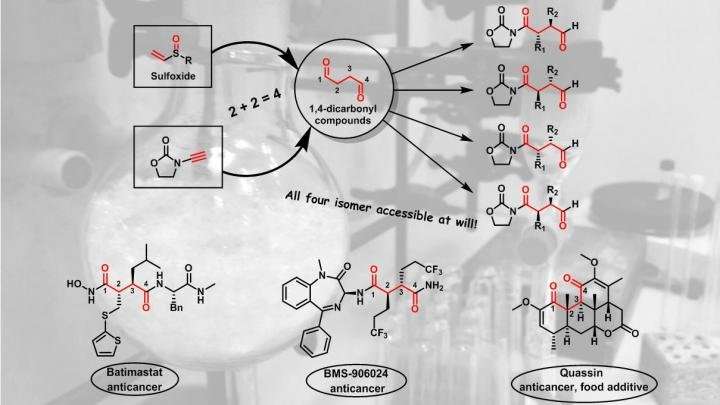Many natural products and drugs feature a so-called dicarbonyl motif— in certain cases, however, their preparation poses a challenge to organic chemists. In their most recent work, Nuno Maulide and his coworkers from the University of Vienna present a new route for these molecules. They use oxidized sulfur compounds, even though sulfur is not included in the final product. The results are now published in Science.
Organic chemists are constantly seeking new molecules for novel drugs and materials. To synthesise molecules, they will analyse the functional groups present within the target and choose a suitable strategy accordingly. However, for some molecules, identifying a suitable strategy can be very challenging, for instance, when the distances between the functionalities in the molecule do not match the “natural” polarity of potential precursors.
One classical example is that where two carbon-oxygen double bonds (also called “carbonyl” groups) are separated by four carbon atoms. “These 1,4-dicarbonyl compounds are significantly more difficult to make than the corresponding 1,3- or 1,5-analogues, and this is something we teach every student in Organic Chemistry I at the University of Vienna,” says Nuno Maulide, professor for organic synthesis at the Institute of Organic Chemistry of the University.
To make these motifs in the lab, no good strategy exists. “What we teach our students is that the polarity inversion of one of the reaction partners is required, but there is no really good solution to the problem,” says Maulide. This is a severe problem, as 1,4-dicarbonyls are found in many natural products, drug targets and several enzyme inhibitors used in pharmaceuticals.
Nuno Maulide and his coworkers from the Organic Chemistry Department of the University of Vienna have now developed a new synthetic route to these structures using reagents called sulfoxides, an oxidized species of sulfur. “What makes our method so fascinating is that sulfur is decisively involved in the reaction, but it doesn’t even appear in the final molecule,” explains Immo Klose, DOC-fellow of the Austrian Academy of Sciences and co-first author of the study. “This is also what makes this reaction intriguing, because it is not obvious at first sight how the starting materials form the product,” said Klose. Indeed, during the reaction, sulfur leaves the reactive molecule in a so-called “traceless” manner, meaning it is not present in the final products.
Find your dream job in the space industry. Check our Space Job Board »
Not only is the sulfoxide partner critical in the reaction, the researchers have shown that by choosing the right starting sulfoxide, each one out of four possible isomers of the product can be obtained selectively. “Our sulfoxide reagents have two positions that can be changed: the sulfur itself and the two carbons that are connected to it. This gives us four possible combinations,” explains Dainis Kaldre, former Postdoc at the Institute of Organic Chemistry and co-first author. “The great thing is, by changing between these 4 possible combinations, we effectively fine-tune the reaction into delivering selectively each of the four configurations of the final product that are possible,” says Kaldre. This makes the method extremely general and powerful.
New drug molecules unlocked
“The flexibility of our method can now be used to make a breathtaking amount of molecules that were not even thinkable before,” explains Maulide. The group has already shown this in the initial report in the journal Science, in which they demonstrate a simple way to make matrix metalloproteinase inhibitors. “There was no good way to make these compounds. In particular, it was very difficult to make a specific configuration in selective way; now, with our method, we can make any one out of the 4 possibilities, at will,” says Maulide.
The reactive species with which the sulfoxides are combined are somewhat exotic intermediates called “vinyl cations.”
“It is remarkable how basic research on ‘exotic molecules’ can so easily result in breakthroughs for society. This is a very welcome—and timely—reminder of the immense value that lies in investing in basic research,” so Maulide concluding.
Provided by:
University of Vienna
More information:
Dainis Kaldre et al. Stereodivergent synthesis of 1,4-dicarbonyls by traceless charge–accelerated sulfonium rearrangement. Science (2018). DOI: 10.1126/science.aat5883
Image:
New selective synthesis of all 1,4-dicarbonyl isomers from sulfoxides and selected important bioactive compounds featuring the 1,4-dicarbonyl motif
Credit: © Maulide Group











